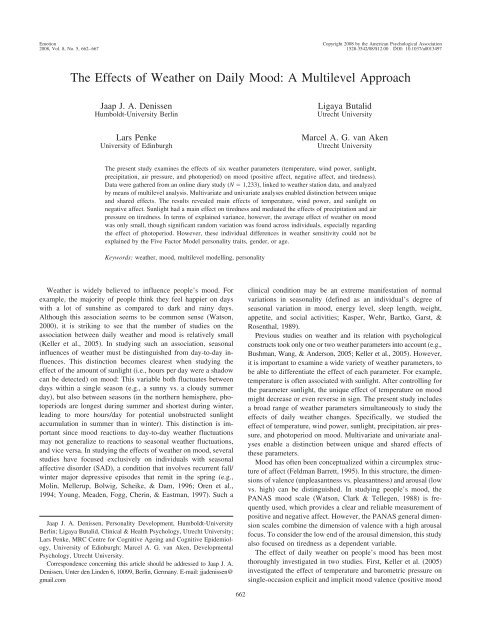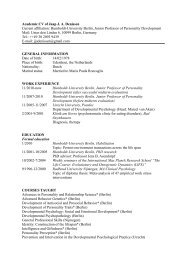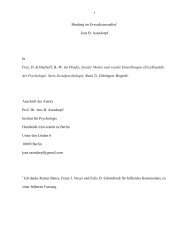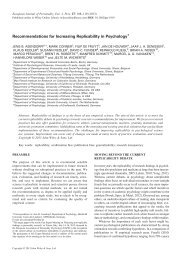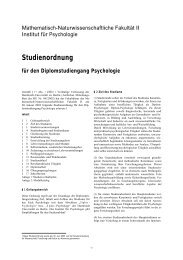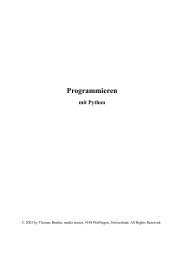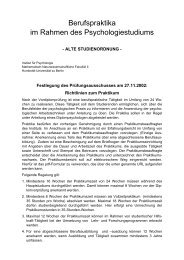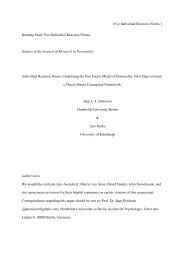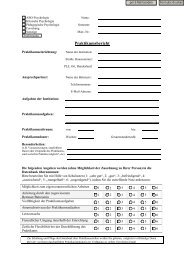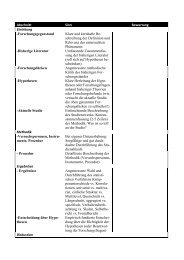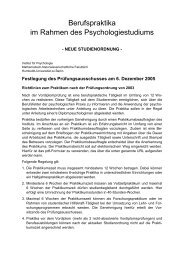The Effects of Weather on Daily Mood: A Multilevel Approach
The Effects of Weather on Daily Mood: A Multilevel Approach
The Effects of Weather on Daily Mood: A Multilevel Approach
Create successful ePaper yourself
Turn your PDF publications into a flip-book with our unique Google optimized e-Paper software.
Emoti<strong>on</strong><br />
Copyright 2008 by the American Psychological Associati<strong>on</strong><br />
2008, Vol. 8, No. 5, 662–667 1528-3542/08/$12.00 DOI: 10.1037/a0013497<br />
<str<strong>on</strong>g>The</str<strong>on</strong>g> <str<strong>on</strong>g>Effects</str<strong>on</strong>g> <str<strong>on</strong>g>of</str<strong>on</strong>g> <str<strong>on</strong>g>Weather</str<strong>on</strong>g> <strong>on</strong> <strong>Daily</strong> <strong>Mood</strong>: A <strong>Multilevel</strong> <strong>Approach</strong><br />
Jaap J. A. Denissen<br />
Humboldt-University Berlin<br />
Lars Penke<br />
University <str<strong>on</strong>g>of</str<strong>on</strong>g> Edinburgh<br />
Ligaya Butalid<br />
Utrecht University<br />
Marcel A. G. van Aken<br />
Utrecht University<br />
<str<strong>on</strong>g>The</str<strong>on</strong>g> present study examines the effects <str<strong>on</strong>g>of</str<strong>on</strong>g> six weather parameters (temperature, wind power, sunlight,<br />
precipitati<strong>on</strong>, air pressure, and photoperiod) <strong>on</strong> mood (positive affect, negative affect, and tiredness).<br />
Data were gathered from an <strong>on</strong>line diary study (N 1,233), linked to weather stati<strong>on</strong> data, and analyzed<br />
by means <str<strong>on</strong>g>of</str<strong>on</strong>g> multilevel analysis. Multivariate and univariate analyses enabled distincti<strong>on</strong> between unique<br />
and shared effects. <str<strong>on</strong>g>The</str<strong>on</strong>g> results revealed main effects <str<strong>on</strong>g>of</str<strong>on</strong>g> temperature, wind power, and sunlight <strong>on</strong><br />
negative affect. Sunlight had a main effect <strong>on</strong> tiredness and mediated the effects <str<strong>on</strong>g>of</str<strong>on</strong>g> precipitati<strong>on</strong> and air<br />
pressure <strong>on</strong> tiredness. In terms <str<strong>on</strong>g>of</str<strong>on</strong>g> explained variance, however, the average effect <str<strong>on</strong>g>of</str<strong>on</strong>g> weather <strong>on</strong> mood<br />
was <strong>on</strong>ly small, though significant random variati<strong>on</strong> was found across individuals, especially regarding<br />
the effect <str<strong>on</strong>g>of</str<strong>on</strong>g> photoperiod. However, these individual differences in weather sensitivity could not be<br />
explained by the Five Factor Model pers<strong>on</strong>ality traits, gender, or age.<br />
Keywords: weather, mood, multilevel modelling, pers<strong>on</strong>ality<br />
<str<strong>on</strong>g>Weather</str<strong>on</strong>g> is widely believed to influence people’s mood. For<br />
example, the majority <str<strong>on</strong>g>of</str<strong>on</strong>g> people think they feel happier <strong>on</strong> days<br />
with a lot <str<strong>on</strong>g>of</str<strong>on</strong>g> sunshine as compared to dark and rainy days.<br />
Although this associati<strong>on</strong> seems to be comm<strong>on</strong> sense (Wats<strong>on</strong>,<br />
2000), it is striking to see that the number <str<strong>on</strong>g>of</str<strong>on</strong>g> studies <strong>on</strong> the<br />
associati<strong>on</strong> between daily weather and mood is relatively small<br />
(Keller et al., 2005). In studying such an associati<strong>on</strong>, seas<strong>on</strong>al<br />
influences <str<strong>on</strong>g>of</str<strong>on</strong>g> weather must be distinguished from day-to-day influences.<br />
This distincti<strong>on</strong> becomes clearest when studying the<br />
effect <str<strong>on</strong>g>of</str<strong>on</strong>g> the amount <str<strong>on</strong>g>of</str<strong>on</strong>g> sunlight (i.e., hours per day were a shadow<br />
can be detected) <strong>on</strong> mood: This variable both fluctuates between<br />
days within a single seas<strong>on</strong> (e.g., a sunny vs. a cloudy summer<br />
day), but also between seas<strong>on</strong>s (in the northern hemisphere, photoperiods<br />
are l<strong>on</strong>gest during summer and shortest during winter,<br />
leading to more hours/day for potential unobstructed sunlight<br />
accumulati<strong>on</strong> in summer than in winter). This distincti<strong>on</strong> is important<br />
since mood reacti<strong>on</strong>s to day-to-day weather fluctuati<strong>on</strong>s<br />
may not generalize to reacti<strong>on</strong>s to seas<strong>on</strong>al weather fluctuati<strong>on</strong>s,<br />
and vice versa. In studying the effects <str<strong>on</strong>g>of</str<strong>on</strong>g> weather <strong>on</strong> mood, several<br />
studies have focused exclusively <strong>on</strong> individuals with seas<strong>on</strong>al<br />
affective disorder (SAD), a c<strong>on</strong>diti<strong>on</strong> that involves recurrent fall/<br />
winter major depressive episodes that remit in the spring (e.g.,<br />
Molin, Mellerup, Bolwig, Scheike, & Dam, 1996; Oren et al.,<br />
1994; Young, Meaden, Fogg, Cherin, & Eastman, 1997). Such a<br />
Jaap J. A. Denissen, Pers<strong>on</strong>ality Development, Humboldt-University<br />
Berlin; Ligaya Butalid, Clinical & Health Psychology, Utrecht University;<br />
Lars Penke, MRC Centre for Cognitive Ageing and Cognitive Epidemiology,<br />
University <str<strong>on</strong>g>of</str<strong>on</strong>g> Edinburgh; Marcel A. G. van Aken, Developmental<br />
Psychology, Utrecht University.<br />
Corresp<strong>on</strong>dence c<strong>on</strong>cerning this article should be addressed to Jaap J. A.<br />
Denissen, Unter den Linden 6, 10099, Berlin, Germany. E-mail: jjadenissen@<br />
gmail.com<br />
clinical c<strong>on</strong>diti<strong>on</strong> may be an extreme manifestati<strong>on</strong> <str<strong>on</strong>g>of</str<strong>on</strong>g> normal<br />
variati<strong>on</strong>s in seas<strong>on</strong>ality (defined as an individual’s degree <str<strong>on</strong>g>of</str<strong>on</strong>g><br />
seas<strong>on</strong>al variati<strong>on</strong> in mood, energy level, sleep length, weight,<br />
appetite, and social activities; Kasper, Wehr, Bartko, Garst, &<br />
Rosenthal, 1989).<br />
Previous studies <strong>on</strong> weather and its relati<strong>on</strong> with psychological<br />
c<strong>on</strong>structs took <strong>on</strong>ly <strong>on</strong>e or two weather parameters into account (e.g.,<br />
Bushman, Wang, & Anders<strong>on</strong>, 2005; Keller et al., 2005). However,<br />
it is important to examine a wide variety <str<strong>on</strong>g>of</str<strong>on</strong>g> weather parameters, to<br />
be able to differentiate the effect <str<strong>on</strong>g>of</str<strong>on</strong>g> each parameter. For example,<br />
temperature is <str<strong>on</strong>g>of</str<strong>on</strong>g>ten associated with sunlight. After c<strong>on</strong>trolling for<br />
the parameter sunlight, the unique effect <str<strong>on</strong>g>of</str<strong>on</strong>g> temperature <strong>on</strong> mood<br />
might decrease or even reverse in sign. <str<strong>on</strong>g>The</str<strong>on</strong>g> present study includes<br />
a broad range <str<strong>on</strong>g>of</str<strong>on</strong>g> weather parameters simultaneously to study the<br />
effects <str<strong>on</strong>g>of</str<strong>on</strong>g> daily weather changes. Specifically, we studied the<br />
effect <str<strong>on</strong>g>of</str<strong>on</strong>g> temperature, wind power, sunlight, precipitati<strong>on</strong>, air pressure,<br />
and photoperiod <strong>on</strong> mood. Multivariate and univariate analyses<br />
enable a distincti<strong>on</strong> between unique and shared effects <str<strong>on</strong>g>of</str<strong>on</strong>g><br />
these parameters.<br />
<strong>Mood</strong> has <str<strong>on</strong>g>of</str<strong>on</strong>g>ten been c<strong>on</strong>ceptualized within a circumplex structure<br />
<str<strong>on</strong>g>of</str<strong>on</strong>g> affect (Feldman Barrett, 1995). In this structure, the dimensi<strong>on</strong>s<br />
<str<strong>on</strong>g>of</str<strong>on</strong>g> valence (unpleasantness vs. pleasantness) and arousal (low<br />
vs. high) can be distinguished. In studying people’s mood, the<br />
PANAS mood scale (Wats<strong>on</strong>, Clark & Tellegen, 1988) is frequently<br />
used, which provides a clear and reliable measurement <str<strong>on</strong>g>of</str<strong>on</strong>g><br />
positive and negative affect. However, the PANAS general dimensi<strong>on</strong><br />
scales combine the dimensi<strong>on</strong> <str<strong>on</strong>g>of</str<strong>on</strong>g> valence with a high arousal<br />
focus. To c<strong>on</strong>sider the low end <str<strong>on</strong>g>of</str<strong>on</strong>g> the arousal dimensi<strong>on</strong>, this study<br />
also focused <strong>on</strong> tiredness as a dependent variable.<br />
<str<strong>on</strong>g>The</str<strong>on</strong>g> effect <str<strong>on</strong>g>of</str<strong>on</strong>g> daily weather <strong>on</strong> people’s mood has been most<br />
thoroughly investigated in two studies. First, Keller et al. (2005)<br />
investigated the effect <str<strong>on</strong>g>of</str<strong>on</strong>g> temperature and barometric pressure <strong>on</strong><br />
single-occasi<strong>on</strong> explicit and implicit mood valence (positive mood<br />
662
WEATHER CHANGES AND MOOD<br />
663<br />
subtracted by negative mood) and cogniti<strong>on</strong> (memory and cognitive<br />
style) in three different samples <str<strong>on</strong>g>of</str<strong>on</strong>g> (mostly) North American<br />
participants. <str<strong>on</strong>g>The</str<strong>on</strong>g>y found no c<strong>on</strong>sistent main effects <str<strong>on</strong>g>of</str<strong>on</strong>g> weather <strong>on</strong><br />
mood, though they found a moderator effect <str<strong>on</strong>g>of</str<strong>on</strong>g> both seas<strong>on</strong> and the<br />
time participants’ spent in the open air: On spring days when<br />
people spent a lot <str<strong>on</strong>g>of</str<strong>on</strong>g> time outside, mood was positively associated<br />
with air temperature. On summer days, however, spending more<br />
time outside <strong>on</strong> warm days was associated with decreased mood In<br />
additi<strong>on</strong>, <strong>on</strong> spring days, barometric pressure was positively associated<br />
with mood (no main or interacti<strong>on</strong> effects were reported for<br />
the other seas<strong>on</strong>s).<br />
Wats<strong>on</strong> (2000) collected diary reports by eight different samples<br />
<str<strong>on</strong>g>of</str<strong>on</strong>g> students from Texas (total N 478) between 1985 and 1993,<br />
during either fall or spring. Participants reported their mood <strong>on</strong> an<br />
average <str<strong>on</strong>g>of</str<strong>on</strong>g> 43.6 occasi<strong>on</strong>s), using the 11 subscales <str<strong>on</strong>g>of</str<strong>on</strong>g> the<br />
PANAS-X (Wats<strong>on</strong> & Clark, 1994). Wats<strong>on</strong> (2000) focused his<br />
analyses <strong>on</strong> the amount <str<strong>on</strong>g>of</str<strong>on</strong>g> sunshine and rain, but found no c<strong>on</strong>sistent<br />
effects <strong>on</strong> any <str<strong>on</strong>g>of</str<strong>on</strong>g> the daily mood variables. To investigate<br />
whether mood would be associated with weather <strong>on</strong> days with<br />
extreme weather c<strong>on</strong>diti<strong>on</strong>s, Wats<strong>on</strong> (2000) also compared days<br />
with 0% sunshine with days with 100% sunshine but found that<br />
sunshine <strong>on</strong>ly influenced the overall intensity <str<strong>on</strong>g>of</str<strong>on</strong>g> participants’<br />
mood reports, not the valence <str<strong>on</strong>g>of</str<strong>on</strong>g> these reports (i.e., participants<br />
reported more extreme scores <strong>on</strong> both positive and negative mood<br />
scales).<br />
To summarize, both the Keller et al. (2005) and the Wats<strong>on</strong><br />
(2000) study found no c<strong>on</strong>sistent main effects <str<strong>on</strong>g>of</str<strong>on</strong>g> weather <strong>on</strong> mood.<br />
However, the c<strong>on</strong>clusi<strong>on</strong>s <str<strong>on</strong>g>of</str<strong>on</strong>g> both studies are limited by a number<br />
<str<strong>on</strong>g>of</str<strong>on</strong>g> factors. First, they almost exclusively focused <strong>on</strong> participants<br />
from North America, so it is unclear whether effects can be<br />
generalized to other regi<strong>on</strong>s. Sec<strong>on</strong>d, the study by Keller et al.<br />
(2005; though not the <strong>on</strong>e by Wats<strong>on</strong>, 2000) investigated <strong>on</strong>ly the<br />
effects <str<strong>on</strong>g>of</str<strong>on</strong>g> two weather parameters and <strong>on</strong>e mood valence variable.<br />
To extend these findings, the present study used a broader approach<br />
in studying the relati<strong>on</strong> between weather and mood by<br />
including a wider variety <str<strong>on</strong>g>of</str<strong>on</strong>g> weather parameters and including<br />
three aspects <str<strong>on</strong>g>of</str<strong>on</strong>g> mood. Going bey<strong>on</strong>d both the Keller et al. (2005)<br />
and the Wats<strong>on</strong> (2000) study, the current investigati<strong>on</strong> also studies<br />
the effect <str<strong>on</strong>g>of</str<strong>on</strong>g> wind power and photoperiod <strong>on</strong> mood. Third, the<br />
present study also extends previous research by examining individual<br />
differences in sensitivity to weather fluctuati<strong>on</strong>s. It is expected<br />
that the effects <str<strong>on</strong>g>of</str<strong>on</strong>g> weather <strong>on</strong> mood differ across individuals.<br />
Although individual differences in sensitivity to daily<br />
weather have not been studied previously, the results <str<strong>on</strong>g>of</str<strong>on</strong>g> some<br />
studies suggest a link between seas<strong>on</strong>ality and pers<strong>on</strong>ality, especially<br />
c<strong>on</strong>cerning the trait <str<strong>on</strong>g>of</str<strong>on</strong>g> neuroticism (e.g., Jang, Lam, Livesley,<br />
& Vern<strong>on</strong>, 1997; Murray, Hay, & Armstr<strong>on</strong>g, 1995). <str<strong>on</strong>g>The</str<strong>on</strong>g>refore,<br />
it is interesting to examine whether also a link between<br />
sensitivity to daily weather and pers<strong>on</strong>ality exists.<br />
Pers<strong>on</strong>ality and demographic characteristics will be examined to<br />
see if individual differences in sensitivity to weather changes can<br />
be predicted (Ennis & McC<strong>on</strong>ville, 2004). To adopt an exploratory<br />
approach <str<strong>on</strong>g>of</str<strong>on</strong>g> pers<strong>on</strong>ality as a moderator between daily weather and<br />
mood in the current study, pers<strong>on</strong>ality will be assessed at the broad<br />
level <str<strong>on</strong>g>of</str<strong>on</strong>g> the Five Factor Model. In additi<strong>on</strong>, gender and age will be<br />
included in the analysis. Some studies (e.g., Rosen et al., 1990)<br />
have found a decrease in seas<strong>on</strong>ality and SAD with increasing age,<br />
though it may also require some degree <str<strong>on</strong>g>of</str<strong>on</strong>g> exposure to develop a<br />
sensitivity to the local climate and photoperiod. In additi<strong>on</strong>, seas<strong>on</strong>al<br />
affective disorder is found to have a higher prevalence rate<br />
in women than in men (e.g., Lucht & Kasper, 1999; Rosen et al.,<br />
1990). Finally, the present study investigated the moderating role<br />
<str<strong>on</strong>g>of</str<strong>on</strong>g> seas<strong>on</strong> to replicate the finding by Keller et al. (2005) that<br />
temperature <strong>on</strong>ly affects mood during the spring.<br />
Since the present study examines within-pers<strong>on</strong> associati<strong>on</strong>s<br />
between daily psychological states and daily weather variables,<br />
data have to be collected across a series <str<strong>on</strong>g>of</str<strong>on</strong>g> days (diary method).<br />
Diary methods reduce retrospective bias because <str<strong>on</strong>g>of</str<strong>on</strong>g> minimizing<br />
the time between experiences and the report <str<strong>on</strong>g>of</str<strong>on</strong>g> these experiences<br />
(Bolger, Davis, & Rafaeli, 2003). In this study, the Internet was<br />
used to c<strong>on</strong>duct a diary study. <str<strong>on</strong>g>The</str<strong>on</strong>g> use <str<strong>on</strong>g>of</str<strong>on</strong>g> the Internet might result<br />
in large sample sizes and eases data collecti<strong>on</strong> for a l<strong>on</strong>ger period<br />
<str<strong>on</strong>g>of</str<strong>on</strong>g> time (Michalak, 1998). Data was gathered for an uninterrupted<br />
sequence <str<strong>on</strong>g>of</str<strong>on</strong>g> m<strong>on</strong>ths that include different seas<strong>on</strong>s <str<strong>on</strong>g>of</str<strong>on</strong>g> the year.<br />
To summarize, this study investigates the effects <str<strong>on</strong>g>of</str<strong>on</strong>g> daily<br />
weather <strong>on</strong> people’s mood, while taking individual differences into<br />
account. <str<strong>on</strong>g>The</str<strong>on</strong>g> effects <str<strong>on</strong>g>of</str<strong>on</strong>g> six different weather variables <strong>on</strong> three<br />
separate mood variables are examined. Furthermore, to examine<br />
what might account for individual differences, the Big Five pers<strong>on</strong>ality<br />
traits, gender, and age are included in the study. In<br />
additi<strong>on</strong>, we investigated the possible moderating role <str<strong>on</strong>g>of</str<strong>on</strong>g> seas<strong>on</strong>.<br />
<str<strong>on</strong>g>The</str<strong>on</strong>g> aim <str<strong>on</strong>g>of</str<strong>on</strong>g> this exploratory approach is to get a further understanding<br />
<str<strong>on</strong>g>of</str<strong>on</strong>g> the possible relati<strong>on</strong> between weather, pers<strong>on</strong>ality, and<br />
mood.<br />
Participants and Design<br />
Method<br />
Initially, 1,668 individuals signed up for the current study. Only<br />
the 1,233 resp<strong>on</strong>dents (73.9%) who provided a German postal zip<br />
code and an email address that indicated residence in Germany<br />
were included in the study, so that we were able to match resp<strong>on</strong>dents<br />
with the available weather informati<strong>on</strong>. Participants had a<br />
mean age <str<strong>on</strong>g>of</str<strong>on</strong>g> 27.67 (SD 9.77), with a range from 13 to 68 years.<br />
A majority <str<strong>on</strong>g>of</str<strong>on</strong>g> 88.6% (1092) <str<strong>on</strong>g>of</str<strong>on</strong>g> the resp<strong>on</strong>dents were women.<br />
Participants most <str<strong>on</strong>g>of</str<strong>on</strong>g>ten started their participati<strong>on</strong> in autumn (N <br />
449), followed by summer (N 336), spring (N 233), and<br />
winter (N 215).<br />
Instruments and Procedure<br />
Pretest. Data was gathered by means <str<strong>on</strong>g>of</str<strong>on</strong>g> an <strong>on</strong>line diary, which<br />
focused <strong>on</strong> the determinants <str<strong>on</strong>g>of</str<strong>on</strong>g> individual daily well-being. <str<strong>on</strong>g>The</str<strong>on</strong>g><br />
data was collected between July 2005 and February 2007. Publicity<br />
for this study was generated through links <strong>on</strong> websites dedicated<br />
to psychological research as well as postings <strong>on</strong> <strong>on</strong>line<br />
forums. Before taking part in the diary study, participants completed<br />
an extensive <strong>on</strong>line pretest questi<strong>on</strong>naire (including some<br />
measures irrelevant to the current study). <str<strong>on</strong>g>The</str<strong>on</strong>g> Five Factor Model<br />
pers<strong>on</strong>ality traits were assessed using the Big Five Inventory (BFI;<br />
John & Srivastava, 1999). This scale c<strong>on</strong>tained 42 items measuring<br />
Extraversi<strong>on</strong> (eight items), Neuroticism (seven items), Openness<br />
to Experiences (10 items), C<strong>on</strong>scientiousness (nine items), and<br />
Agreeableness (eight items). Reliability analysis revealed a Cr<strong>on</strong>bach’s<br />
alpha <str<strong>on</strong>g>of</str<strong>on</strong>g> .90 for Extraversi<strong>on</strong>, .85 for Neuroticism, .83 for<br />
Openness, .84 for C<strong>on</strong>scientiousness, and .74 for Agreeableness.<br />
Internet-based diary study. Up<strong>on</strong> completing the pretest questi<strong>on</strong>naire,<br />
participants filled out daily questi<strong>on</strong>naires including
664 DENISSEN ET AL.<br />
measures <str<strong>on</strong>g>of</str<strong>on</strong>g> positive affect, negative affect, and tiredness. <strong>Daily</strong><br />
positive and negative affect were assessed by means <str<strong>on</strong>g>of</str<strong>on</strong>g> the PA-<br />
NAS mood scale (Wats<strong>on</strong> & Clark, 1994). Positive affect was<br />
measured with the items “active,” “alert,” “attentive,” “determined,”<br />
“enthusiastic,” “excited,” “inspired,” “interested,”<br />
“proud,” and “str<strong>on</strong>g,” whereas the scale <str<strong>on</strong>g>of</str<strong>on</strong>g> negative affect c<strong>on</strong>tained<br />
the items “afraid,” “scared,” “nervous,” “jittery,” “irritable,”<br />
“hostile,” “guilty,” “ashamed,” “upset,” and “distressed.” <str<strong>on</strong>g>The</str<strong>on</strong>g><br />
items “sleepy,” “tired,” “sluggish,” and “drowsy” from the<br />
PANAS-fatigue scale (Wats<strong>on</strong> & Clark, 1994) loaded <strong>on</strong> the same<br />
factor as the items “quiet” and “still” that tap into the arousal<br />
dimensi<strong>on</strong> <str<strong>on</strong>g>of</str<strong>on</strong>g> the mood circumplex (Feldman Barrett, 1995), so<br />
they were combined into a single scale <str<strong>on</strong>g>of</str<strong>on</strong>g> daily tiredness. Items<br />
were presented with scales from 1 (“not at all”) to 5 (“very much”).<br />
<str<strong>on</strong>g>The</str<strong>on</strong>g> mean score <strong>on</strong> positive affect in the sample was 2.85 (SD <br />
0.79), negative affect had a mean <str<strong>on</strong>g>of</str<strong>on</strong>g> 1.83 (SD 0.75), and the<br />
mean score <strong>on</strong> tiredness was 2.23 (SD 0.88).<br />
<str<strong>on</strong>g>The</str<strong>on</strong>g> different scales <str<strong>on</strong>g>of</str<strong>on</strong>g> the daily questi<strong>on</strong>naires were presented<br />
in randomized order to avoid the development <str<strong>on</strong>g>of</str<strong>on</strong>g> automatic resp<strong>on</strong>se<br />
sets. <str<strong>on</strong>g>The</str<strong>on</strong>g> questi<strong>on</strong>naire was <strong>on</strong>ly accessible between 9 p.m.<br />
and 4 a.m. Participants were asked to complete 25 daily questi<strong>on</strong>naires<br />
within 30 days. However, not all participants completed the<br />
full 25 questi<strong>on</strong>naires needed for feedback. On average, participants<br />
c<strong>on</strong>tributed 13.75 daily reports (SD 10.30). As an incentive,<br />
participants received feedback regarding the extent to which<br />
a number <str<strong>on</strong>g>of</str<strong>on</strong>g> factors affected their mood during the course <str<strong>on</strong>g>of</str<strong>on</strong>g> the<br />
study (e.g., amount <str<strong>on</strong>g>of</str<strong>on</strong>g> sleep, number <str<strong>on</strong>g>of</str<strong>on</strong>g> social interacti<strong>on</strong>s) after<br />
the last daily report.<br />
Objective weather data. Data from the German <str<strong>on</strong>g>Weather</str<strong>on</strong>g> Institute<br />
(Deutscher Wetterdienst; http://www.dwd.de) was used to<br />
obtain weather data from all German weather stati<strong>on</strong>s. <str<strong>on</strong>g>The</str<strong>on</strong>g> daily<br />
weather variables were matched to the diary data <str<strong>on</strong>g>of</str<strong>on</strong>g> the resp<strong>on</strong>dents<br />
by date and ZIP code. <str<strong>on</strong>g>The</str<strong>on</strong>g> data from the weather stati<strong>on</strong>s<br />
c<strong>on</strong>tained variables that were highly correlated, such as minimum<br />
temperature, maximum temperature, and mean temperature.<br />
<str<strong>on</strong>g>The</str<strong>on</strong>g>refore, a factor analysis with oblique (oblimin) rotati<strong>on</strong> was<br />
c<strong>on</strong>ducted. This resulted in three factors, which were labeled<br />
‘temperature,’ ‘sunlight,’ and ‘wind power.’ <str<strong>on</strong>g>The</str<strong>on</strong>g> variables mean<br />
temperature in degrees Celsius, hours <str<strong>on</strong>g>of</str<strong>on</strong>g> unobstructed sunlight<br />
(i.e., the number <str<strong>on</strong>g>of</str<strong>on</strong>g> hours in which a shadow can be detected), and<br />
mean wind power <strong>on</strong> the Beaufort scale (Bft) were used to represent<br />
these factors in the analysis. <str<strong>on</strong>g>The</str<strong>on</strong>g> variables precipitati<strong>on</strong> in<br />
millimeters and mean air pressure measured in hectopascal (hPa)<br />
did not load <strong>on</strong> <strong>on</strong>e <str<strong>on</strong>g>of</str<strong>on</strong>g> the three defined factors and were therefore<br />
c<strong>on</strong>sidered as separate variables. <str<strong>on</strong>g>The</str<strong>on</strong>g> daily mean temperature<br />
ranged from 17.80 to 28.40 °C (0.04 to 83.12 °F), with a mean<br />
<str<strong>on</strong>g>of</str<strong>on</strong>g> 11.28 (SD 6.62) degrees Celsius (M 52.30, SD 43.92<br />
°F). <str<strong>on</strong>g>The</str<strong>on</strong>g> mean wind power ranged from 0 to 7 Bft (M 2.56,<br />
SD 0.80), sunlight ranged from 0 to 16.50 hours (M 4.76,<br />
SD 4.15), precipitati<strong>on</strong> had a range from 0 to 47.10 mm (M <br />
1.93, SD 3.84), and air pressure had a range from 895.90 to<br />
1042.30 hPa (M 990.86, SD 22.26).<br />
In additi<strong>on</strong>, photoperiod was calculated by subtracting the time <str<strong>on</strong>g>of</str<strong>on</strong>g><br />
sunrise from the time <str<strong>on</strong>g>of</str<strong>on</strong>g> sunset for the various days that were studied<br />
(using the geographical center <str<strong>on</strong>g>of</str<strong>on</strong>g> Germany as the reference point<br />
<strong>on</strong> http://www.s<strong>on</strong>nenaufgang-s<strong>on</strong>nenuntergang.de/). <str<strong>on</strong>g>The</str<strong>on</strong>g> resulting<br />
variable had a range from 7.87 to 16.60 (M 12.33, SD <br />
2.66). Although this variable is obviously c<strong>on</strong>founded with hours<br />
<str<strong>on</strong>g>of</str<strong>on</strong>g> sunlight (see below), photoperiod is completely determined by<br />
calendar date and latitude (e.g., shortest and l<strong>on</strong>gest day length at<br />
the winter and summer solstice, respectively, in the northern<br />
hemisphere), whereas the amount <str<strong>on</strong>g>of</str<strong>on</strong>g> unobstructed sunlight also<br />
taps into day-to-day fluctuati<strong>on</strong>s (e.g., a clouded vs. a sunny<br />
summer day).<br />
Data Analysis<br />
Because data from diary studies are nested data (repeated measures<br />
within an individual) and missings <str<strong>on</strong>g>of</str<strong>on</strong>g>ten occurred because<br />
not all resp<strong>on</strong>dents participated in the study for the full length <str<strong>on</strong>g>of</str<strong>on</strong>g><br />
25 days, multilevel analysis (linear mixed-model using SPSS) was<br />
the method <str<strong>on</strong>g>of</str<strong>on</strong>g> choice to analyze this dataset. Because <str<strong>on</strong>g>of</str<strong>on</strong>g> the large<br />
sample size, <strong>on</strong>ly effects that are significant at the p .01 level<br />
will be reported.<br />
First, a multivariate linear mixed-model analysis with fixed<br />
effects <str<strong>on</strong>g>of</str<strong>on</strong>g> the six weather parameters (Level 1) was c<strong>on</strong>ducted to<br />
identify main effects <str<strong>on</strong>g>of</str<strong>on</strong>g> weather data <strong>on</strong> mood, while c<strong>on</strong>trolling<br />
for the other weather parameters. Sec<strong>on</strong>d, to test whether the<br />
effects <str<strong>on</strong>g>of</str<strong>on</strong>g> weather <strong>on</strong> mood differed across individuals, univariate<br />
linear mixed-model analyses were c<strong>on</strong>ducted including random<br />
effects (slopes). Finally, pers<strong>on</strong>ality and demographic characteristics<br />
(age, gender; Level 2), as well as seas<strong>on</strong> (Level 1) were added<br />
in the linear mixed-models for each weather parameter separately<br />
to explain the expected variance in random effects.<br />
Results<br />
Associati<strong>on</strong>s Between <str<strong>on</strong>g>Weather</str<strong>on</strong>g> Variables<br />
To inspect the degree <str<strong>on</strong>g>of</str<strong>on</strong>g> interdependence between the six<br />
weather variables, these parameters were correlated across the 585<br />
days that were studied. <str<strong>on</strong>g>The</str<strong>on</strong>g> correlati<strong>on</strong>s between the six weather<br />
variables ranged between |.12| and |.76| and were all statistically<br />
significant, with large correlati<strong>on</strong>s (|.5|) between temperature<br />
and photoperiod, sunlight and photoperiod, and temperature and<br />
sunlight (see Table 1). <str<strong>on</strong>g>The</str<strong>on</strong>g> strength <str<strong>on</strong>g>of</str<strong>on</strong>g> these associati<strong>on</strong>s illustrates<br />
the need to distinguish between univariate (i.e., potentially c<strong>on</strong>founded)<br />
and multivariate (i.e., unique) effects <str<strong>on</strong>g>of</str<strong>on</strong>g> weather parameters<br />
<strong>on</strong> mood.<br />
Main <str<strong>on</strong>g>Effects</str<strong>on</strong>g> <str<strong>on</strong>g>of</str<strong>on</strong>g> <str<strong>on</strong>g>Weather</str<strong>on</strong>g> Parameters<br />
Positive affect. Multivariate and univariate linear mixedmodel<br />
analyses revealed no significant ( p .01) main effects <str<strong>on</strong>g>of</str<strong>on</strong>g><br />
temperature, wind power, sunlight, precipitati<strong>on</strong>, air pressure, and<br />
photoperiod <strong>on</strong> positive affect (see Table 2 for standardized regressi<strong>on</strong><br />
coefficients). In additi<strong>on</strong>, it was checked whether temperature<br />
had a curvilinear effect <strong>on</strong> mood. However, including a<br />
quadratic term <str<strong>on</strong>g>of</str<strong>on</strong>g> temperature did not result in better model fit <str<strong>on</strong>g>of</str<strong>on</strong>g><br />
the data for any <str<strong>on</strong>g>of</str<strong>on</strong>g> the three dependent variables. Thus, in further<br />
analyses <str<strong>on</strong>g>of</str<strong>on</strong>g> the data, the effect <str<strong>on</strong>g>of</str<strong>on</strong>g> temperature was treated to be<br />
linear.<br />
<str<strong>on</strong>g>The</str<strong>on</strong>g> random-effects analysis indicated that the variance between<br />
individuals in the effects <str<strong>on</strong>g>of</str<strong>on</strong>g> weather <strong>on</strong> positive affect was significant<br />
( p .01) for all variables except precipitati<strong>on</strong> ( p .013). <str<strong>on</strong>g>The</str<strong>on</strong>g> largest<br />
random effect was found for photoperiod. Overall, these findings<br />
suggest that the directi<strong>on</strong> and the strength <str<strong>on</strong>g>of</str<strong>on</strong>g> the associati<strong>on</strong> between<br />
weather and positive affect differed between individuals.
WEATHER CHANGES AND MOOD<br />
665<br />
Table 1<br />
Pears<strong>on</strong> Correlati<strong>on</strong>s Between <str<strong>on</strong>g>Weather</str<strong>on</strong>g> and <strong>Mood</strong> Variables Across 585 Days<br />
Temperature Wind power Sunlight Rain Air pressure<br />
Wind power .171 <br />
Sunlight .580 .413 <br />
Precipitati<strong>on</strong> .119 .341 .337 <br />
Air pressure .107 .321 .311 .376 <br />
Photoperiod .762 .275 .597 .115 .154 <br />
p .01.<br />
Negative affect. A significantly ( p .01) positive main effect<br />
<str<strong>on</strong>g>of</str<strong>on</strong>g> temperature ( 0.035) and negative main effects <str<strong>on</strong>g>of</str<strong>on</strong>g> wind<br />
power (0.023) and sunlight (0.023) <strong>on</strong> negative affect<br />
were found to be significant in the multivariate linear mixed-model<br />
analysis with fixed effects. Interestingly, these main effects were<br />
not found in the univariate linear mixed-model analyses, indicating<br />
that the positive effect <str<strong>on</strong>g>of</str<strong>on</strong>g> temperature initially suppressed the<br />
negative effect <str<strong>on</strong>g>of</str<strong>on</strong>g> sunlight.<br />
<str<strong>on</strong>g>The</str<strong>on</strong>g> variance between individuals in the effects <str<strong>on</strong>g>of</str<strong>on</strong>g> weather <strong>on</strong><br />
negative affect was found to be significant ( p .01) for all variables<br />
except for precipitati<strong>on</strong>. Thus, the effects <str<strong>on</strong>g>of</str<strong>on</strong>g> all weather parameters <strong>on</strong><br />
negative affect differed between individuals. Interestingly, the random<br />
variance around the slope <str<strong>on</strong>g>of</str<strong>on</strong>g> the (n<strong>on</strong>significant) photoperiod effect<br />
( 2 .166) was more than three times higher than the random<br />
variance around the other slopes ( 2 .050).<br />
Tiredness. In the multivariate mixed-model analysis with<br />
fixed effects, a significantly ( p .01) negative main effect <str<strong>on</strong>g>of</str<strong>on</strong>g><br />
sunlight <strong>on</strong> tiredness was found ( 0.063). <str<strong>on</strong>g>The</str<strong>on</strong>g> results <str<strong>on</strong>g>of</str<strong>on</strong>g> the<br />
univariate mixed-model analyses with random effects also yield a<br />
significant main effect <str<strong>on</strong>g>of</str<strong>on</strong>g> sunlight ( 0.065). In additi<strong>on</strong>,<br />
univariate mixed-model analyses showed main effects <str<strong>on</strong>g>of</str<strong>on</strong>g> precipitati<strong>on</strong><br />
( 0.032) and air pressure ( 0.071).<br />
<str<strong>on</strong>g>The</str<strong>on</strong>g> absence <str<strong>on</strong>g>of</str<strong>on</strong>g> these main effects in the multivariate analysis<br />
suggests that the effects <str<strong>on</strong>g>of</str<strong>on</strong>g> precipitati<strong>on</strong> and air pressure were<br />
partly dependent <strong>on</strong> the effect <str<strong>on</strong>g>of</str<strong>on</strong>g> sunlight. To test whether the<br />
effects <str<strong>on</strong>g>of</str<strong>on</strong>g> precipitati<strong>on</strong> and air pressure were mediated by the<br />
variable sunlight, a mediati<strong>on</strong> analysis was c<strong>on</strong>ducted (Bar<strong>on</strong> &<br />
Kenny, 1986). First, the unique effects <str<strong>on</strong>g>of</str<strong>on</strong>g> precipitati<strong>on</strong> and air<br />
pressure <strong>on</strong> tiredness were found to be significant, but disappeared<br />
when c<strong>on</strong>trolling for sunlight (see Table 2). Sec<strong>on</strong>d, the associati<strong>on</strong><br />
between sunlight and tiredness was significant (see Table 2),<br />
with more sunlight being associated with less tiredness. Finally,<br />
the negative associati<strong>on</strong> between precipitati<strong>on</strong> and sunlight and the<br />
positive associati<strong>on</strong> between air pressure and sunlight was significant<br />
(see Table 1). <str<strong>on</strong>g>The</str<strong>on</strong>g>refore, it can be c<strong>on</strong>cluded that sunlight<br />
significantly mediated the effects <str<strong>on</strong>g>of</str<strong>on</strong>g> precipitati<strong>on</strong> and air pressure<br />
<strong>on</strong> tiredness.<br />
<str<strong>on</strong>g>The</str<strong>on</strong>g> random-effects analyses revealed significant ( p .01)<br />
random slope variance between individuals in the effects <str<strong>on</strong>g>of</str<strong>on</strong>g> all<br />
weather variables <strong>on</strong> tiredness, except for wind power. <str<strong>on</strong>g>The</str<strong>on</strong>g>se<br />
findings suggest that the effects <str<strong>on</strong>g>of</str<strong>on</strong>g> weather <strong>on</strong> tiredness differ<br />
between individuals. Notably, the between-pers<strong>on</strong> variance around<br />
the slope <str<strong>on</strong>g>of</str<strong>on</strong>g> photoperiod was again much higher than the variance<br />
around the slope <str<strong>on</strong>g>of</str<strong>on</strong>g> the other weather variables.<br />
Including Variables <strong>on</strong> the Pers<strong>on</strong> Level in the Models<br />
<str<strong>on</strong>g>The</str<strong>on</strong>g> random-effects analysis <strong>on</strong> Level 1 (weather variables)<br />
revealed that the effects <str<strong>on</strong>g>of</str<strong>on</strong>g> weather variables <strong>on</strong> people’s mood<br />
differed between individuals. To examine whether pers<strong>on</strong> characteristics<br />
such as pers<strong>on</strong>ality traits, age, and gender could account<br />
for these individual differences, these variables were included as<br />
predictors <str<strong>on</strong>g>of</str<strong>on</strong>g> the slope between each weather parameter and mood<br />
outcome combinati<strong>on</strong>. In additi<strong>on</strong>, the effect <str<strong>on</strong>g>of</str<strong>on</strong>g> weather <strong>on</strong> mood<br />
was allowed to vary according to seas<strong>on</strong> (with separate dummies<br />
for spring, summer, and autumn). After B<strong>on</strong>ferr<strong>on</strong>i correcti<strong>on</strong> to<br />
decrease the possibility <str<strong>on</strong>g>of</str<strong>on</strong>g> capitalizati<strong>on</strong> by chance (z 3.58, p <br />
.0003 when applying an alpha level <str<strong>on</strong>g>of</str<strong>on</strong>g> .05), the interacti<strong>on</strong> effects<br />
<str<strong>on</strong>g>of</str<strong>on</strong>g> the weather parameters and the Big Five, age, and gender were<br />
not found to be significant. <str<strong>on</strong>g>The</str<strong>on</strong>g>se variables were thus unable to<br />
Table 2<br />
Regressi<strong>on</strong> Coefficients <str<strong>on</strong>g>of</str<strong>on</strong>g> the Main <str<strong>on</strong>g>Effects</str<strong>on</strong>g> <str<strong>on</strong>g>of</str<strong>on</strong>g> <str<strong>on</strong>g>Weather</str<strong>on</strong>g> Parameters <strong>on</strong> Positive Affect, Negative Affect, and Tiredness<br />
Positive affect Negative affect Tiredness<br />
Multivar. Univar. Multivar. Univar. Multivar. Univar.<br />
2 2 2<br />
Temperature .016 .015 .063 .035 .026 .044 .019 .007 .050 <br />
Wind power .006 .012 .009 .023 .016 .008 .001 .017 .004<br />
Sunlight .012 .017 .012 .023 .013 .009 .063 .065 .009 <br />
Precipitati<strong>on</strong> .002 .011 .004 .001 .001 .002 .011 .032 .004 <br />
Air pressure .023 .031 .047 .010 .018 .048 .032 .071 .031 <br />
Photoperiod .011 .006 .105 .000 .019 .166 .042 .043 .206 <br />
Note. regressi<strong>on</strong> weight based <strong>on</strong> standardized variables; 2 random variance; Multivariate analyses are with fixed effects, univariate analyses are<br />
with random effects.<br />
p .01.<br />
p .001.
666 DENISSEN ET AL.<br />
explain the individual differences in the effect <str<strong>on</strong>g>of</str<strong>on</strong>g> weather <strong>on</strong> mood.<br />
In additi<strong>on</strong>, three-way interacti<strong>on</strong> effects <str<strong>on</strong>g>of</str<strong>on</strong>g> weather, pers<strong>on</strong>ality<br />
traits, and gender were examined, but no significant effect was<br />
found. However, we did find a significantly negative interacti<strong>on</strong><br />
effect between seas<strong>on</strong> and wind power in explaining fluctuati<strong>on</strong>s<br />
in positive affect, indicating that the experience <str<strong>on</strong>g>of</str<strong>on</strong>g> a windy day had<br />
a more negative effect <strong>on</strong> mood in summers and springs than<br />
during winters and autumns.<br />
Discussi<strong>on</strong><br />
<str<strong>on</strong>g>The</str<strong>on</strong>g> aim <str<strong>on</strong>g>of</str<strong>on</strong>g> the study was to investigate the effect <str<strong>on</strong>g>of</str<strong>on</strong>g> daily<br />
weather changes <strong>on</strong> people’s mood. It was expected that individual<br />
differences in sensitivity to weather changes exist. <str<strong>on</strong>g>The</str<strong>on</strong>g> results <str<strong>on</strong>g>of</str<strong>on</strong>g><br />
the current study showed no significant main effects <str<strong>on</strong>g>of</str<strong>on</strong>g> daily<br />
weather <strong>on</strong> positive affect. This result is c<strong>on</strong>sistent with findings<br />
by Keller et al. (2005) and Wats<strong>on</strong> (2000), who also did not find<br />
effects <str<strong>on</strong>g>of</str<strong>on</strong>g> weather <strong>on</strong> overall mood valence. Going against comm<strong>on</strong>ly<br />
held c<strong>on</strong>cepti<strong>on</strong>s (Wats<strong>on</strong>, 2000), it is interesting to note<br />
that n<strong>on</strong>e <str<strong>on</strong>g>of</str<strong>on</strong>g> the six weather parameters had any significant main<br />
effects <strong>on</strong> positive mood. Accordingly, the idea that pleasant<br />
weather increases people’s positive mood in general is not supported<br />
by the findings <str<strong>on</strong>g>of</str<strong>on</strong>g> this study, although the finding <str<strong>on</strong>g>of</str<strong>on</strong>g><br />
significant between-pers<strong>on</strong> variance suggests that such a link may<br />
still exist for some individuals (while simultaneously a reverse<br />
effect holds for others).<br />
Significant main effects <str<strong>on</strong>g>of</str<strong>on</strong>g> temperature, wind power, and sunlight<br />
<strong>on</strong> negative affect were found. <str<strong>on</strong>g>The</str<strong>on</strong>g> difference between the<br />
multivariate and univariate results showed that it was very informative<br />
to include different weather variables to identify the unique<br />
effect <str<strong>on</strong>g>of</str<strong>on</strong>g> each variable. <str<strong>on</strong>g>The</str<strong>on</strong>g> multivariate analysis showed unique<br />
effects <str<strong>on</strong>g>of</str<strong>on</strong>g> temperature, wind power, and sunlight, whereas the effects<br />
<str<strong>on</strong>g>of</str<strong>on</strong>g> temperature and sunlight were not visible in the univariate analyses<br />
because <str<strong>on</strong>g>of</str<strong>on</strong>g> c<strong>on</strong>founds. Because univariate analyses do not c<strong>on</strong>trol<br />
for other variables, positive and negative effects might cancel each<br />
other out.<br />
Sunlight was found to have a significant main effect <strong>on</strong> tiredness<br />
and mediated the effect <str<strong>on</strong>g>of</str<strong>on</strong>g> precipitati<strong>on</strong> and air pressure <strong>on</strong> tiredness.<br />
Vitamin D 3 , which is produced in skin exposed to the<br />
horm<strong>on</strong>e <str<strong>on</strong>g>of</str<strong>on</strong>g> sunlight, has been found to change serot<strong>on</strong>in levels in<br />
the brain, which could account for changes in mood (Lansdowne<br />
& Provost, 1998). <str<strong>on</strong>g>The</str<strong>on</strong>g>refore, lower levels <str<strong>on</strong>g>of</str<strong>on</strong>g> vitamin D 3 could be<br />
resp<strong>on</strong>sible for increases in negative affect and tiredness.<br />
As indicated by the relatively small regressi<strong>on</strong> weights (|.071|),<br />
weather fluctuati<strong>on</strong>s accounted for very little variance in people’s<br />
day-to-day mood. This result may be unexpected given the<br />
existence <str<strong>on</strong>g>of</str<strong>on</strong>g> comm<strong>on</strong>ly held c<strong>on</strong>cepti<strong>on</strong>s that weather exerts a<br />
str<strong>on</strong>g influence <strong>on</strong> mood (Wats<strong>on</strong>, 2000), though it replicates<br />
findings by Wats<strong>on</strong> (2000) and Keller et al. (2005), who also<br />
failed to report main effects. A number <str<strong>on</strong>g>of</str<strong>on</strong>g> factors may explain<br />
the discrepancy between empirical results and widely held<br />
beliefs (see also Wats<strong>on</strong>, 2000). For example, it may be that<br />
these beliefs are a reflecti<strong>on</strong> <str<strong>on</strong>g>of</str<strong>on</strong>g> our historical (and possibly<br />
culturally transmitted) past, when people were much more<br />
dependent <strong>on</strong> weather-related phenomena (e.g., for shelter and<br />
food). It may also be that the discrepancy is because <str<strong>on</strong>g>of</str<strong>on</strong>g> a small<br />
number <str<strong>on</strong>g>of</str<strong>on</strong>g> extreme cases (e.g., individuals with SAD) who<br />
indeed report a str<strong>on</strong>g associati<strong>on</strong> between weather and mood.<br />
Such cases may leave a very vivid impressi<strong>on</strong> <strong>on</strong> others, but the<br />
existence <str<strong>on</strong>g>of</str<strong>on</strong>g> significant between-pers<strong>on</strong> variance against the<br />
background <str<strong>on</strong>g>of</str<strong>on</strong>g> a null effect in the general populati<strong>on</strong> suggests<br />
that these extreme cases are <str<strong>on</strong>g>of</str<strong>on</strong>g>fset by individuals with strikingly<br />
different weather dependencies (e.g., people who become sadder<br />
during summers instead <str<strong>on</strong>g>of</str<strong>on</strong>g> winters).<br />
<str<strong>on</strong>g>The</str<strong>on</strong>g> random effects analyses indicated that the effects <str<strong>on</strong>g>of</str<strong>on</strong>g><br />
weather <strong>on</strong> positive affect, negative affect, and tiredness varied<br />
significantly across individuals. This was especially true for the<br />
effect <str<strong>on</strong>g>of</str<strong>on</strong>g> photoperiod. Even though the within-subject range <str<strong>on</strong>g>of</str<strong>on</strong>g> this<br />
variable (M 0.83, SD 0.73) was vastly reduced when compared<br />
to the range <str<strong>on</strong>g>of</str<strong>on</strong>g> the amount <str<strong>on</strong>g>of</str<strong>on</strong>g> hours with unobstructed<br />
sunlight (M 7.56, SD 4.64), the random slope variance<br />
between pers<strong>on</strong>s was between 9 (positive affect) and 23 (tiredness)<br />
times greater in the former when compared to the latter. On<br />
average, the random effect for photoperiod was no less than 21<br />
times greater than the average random effect <str<strong>on</strong>g>of</str<strong>on</strong>g> the other five<br />
weather variables, indicating that individual differences in reacti<strong>on</strong>s<br />
to changes in photoperiod are much more extreme than<br />
reacti<strong>on</strong>s to day-to-day weather fluctuati<strong>on</strong>s. This means that<br />
whereas some individuals may react to the shortening <str<strong>on</strong>g>of</str<strong>on</strong>g> daylight<br />
time with a relatively str<strong>on</strong>g darkening <str<strong>on</strong>g>of</str<strong>on</strong>g> their mood, the emoti<strong>on</strong>s<br />
<str<strong>on</strong>g>of</str<strong>on</strong>g> other individuals may actually improve equally str<strong>on</strong>gly as a<br />
result <str<strong>on</strong>g>of</str<strong>on</strong>g> this seas<strong>on</strong>al change. <str<strong>on</strong>g>The</str<strong>on</strong>g> former individuals may be the<br />
<strong>on</strong>es who fall prey to SAD during the dark seas<strong>on</strong>, though more<br />
research is needed to substantiate this c<strong>on</strong>clusi<strong>on</strong>.<br />
Inclusi<strong>on</strong> <str<strong>on</strong>g>of</str<strong>on</strong>g> the Five Factor Model pers<strong>on</strong>ality traits, gender and<br />
age, did not reveal more moderati<strong>on</strong> effects <str<strong>on</strong>g>of</str<strong>on</strong>g> the pers<strong>on</strong>-level<br />
variables than expected by chance. In other words, people seem to<br />
differ in the effects <str<strong>on</strong>g>of</str<strong>on</strong>g> weather <strong>on</strong> mood in a way that cannot be<br />
explained by the Five Factor Model pers<strong>on</strong>ality traits, age, or<br />
gender. This might suggest that weather sensitivity is an individual<br />
difference variable by itself. Research <strong>on</strong> diurnal types (e.g.,<br />
Jacks<strong>on</strong> & Gerard, 1996) and seas<strong>on</strong>ality (Reid, Towell, & Golding,<br />
2000) also found individual differences that were independent<br />
to other pers<strong>on</strong>ality traits. <str<strong>on</strong>g>The</str<strong>on</strong>g> findings <str<strong>on</strong>g>of</str<strong>on</strong>g> the present study suggest<br />
that people can also differ in weather sensitivity, independent from<br />
other pers<strong>on</strong>ality traits.<br />
<str<strong>on</strong>g>The</str<strong>on</strong>g> current study also investigated the moderating effect <str<strong>on</strong>g>of</str<strong>on</strong>g><br />
seas<strong>on</strong> <strong>on</strong> the associati<strong>on</strong> between weather and mood in an attempt<br />
to replicate the finding by Keller et al. (2005) that weather fluctuati<strong>on</strong>s<br />
have an especially str<strong>on</strong>g effect in spring. C<strong>on</strong>sistent with<br />
this, we found that wind power had a more negative effect <strong>on</strong><br />
positive mood during spring and summer. This might be because<br />
<str<strong>on</strong>g>of</str<strong>on</strong>g> the fact that people spend more <str<strong>on</strong>g>of</str<strong>on</strong>g> their leisure time outside<br />
during these periods, so experiencing str<strong>on</strong>g winds represents more<br />
<str<strong>on</strong>g>of</str<strong>on</strong>g> a hassle, though this c<strong>on</strong>clusi<strong>on</strong> is highly speculative and needs<br />
to be backed up by future research.<br />
Strengths. Usually, causal effects can <strong>on</strong>ly be identified in<br />
experimental designs. However, weather is an external variable<br />
that cannot be influenced by individuals’ mood or any other third<br />
variable. Although our naturalistic design did not allow us to<br />
establish causality in the strict (experimental) sense, we believe<br />
that are findings are highly c<strong>on</strong>sistent with a causal model that<br />
flows from weather to mood (although we acknowledge that our<br />
results remain silent regarding the processes that mediate associati<strong>on</strong>s<br />
between weather and mood, such as physiological processes<br />
or daily activities). Furthermore, the data collecti<strong>on</strong> for the current<br />
study ran over an 18-m<strong>on</strong>th period, spanning all seas<strong>on</strong>s, which<br />
provided a robust examinati<strong>on</strong> <str<strong>on</strong>g>of</str<strong>on</strong>g> the associati<strong>on</strong> between weather
WEATHER CHANGES AND MOOD<br />
667<br />
and mood and the moderating effect <str<strong>on</strong>g>of</str<strong>on</strong>g> seas<strong>on</strong>. Finally, the Webbased<br />
data collecti<strong>on</strong> ensured access to a large populati<strong>on</strong>, which<br />
resulted in a large and heterogeneous sample from all across<br />
Germany.<br />
Limitati<strong>on</strong>s. Resp<strong>on</strong>se to the questi<strong>on</strong>naire was based <strong>on</strong> voluntary<br />
participati<strong>on</strong> <str<strong>on</strong>g>of</str<strong>on</strong>g> the study, which likely resulted in selecti<strong>on</strong><br />
bias (e.g., unequal gender distributi<strong>on</strong>). Furthermore, the relati<strong>on</strong><br />
between daily weather and mood were found in a moderate maritime/c<strong>on</strong>tinental<br />
climate and might not generalize to other climate<br />
types. In additi<strong>on</strong>, we failed to assess the time that participants<br />
spent outside, which may have emerged as an important moderator<br />
<str<strong>on</strong>g>of</str<strong>on</strong>g> the effect <str<strong>on</strong>g>of</str<strong>on</strong>g> weather <strong>on</strong> mood (Keller et al., 2005). A final<br />
limitati<strong>on</strong> is that we relied <strong>on</strong> self-reported mood that may be<br />
biased by implicit theories regarding the associati<strong>on</strong> between<br />
weather and mood. This might especially be the case given that the<br />
framing <str<strong>on</strong>g>of</str<strong>on</strong>g> the study (focusing <strong>on</strong> the determinants <str<strong>on</strong>g>of</str<strong>on</strong>g> well-being)<br />
may have primed some subjects to reflect about the types <str<strong>on</strong>g>of</str<strong>on</strong>g><br />
external factors affecting their mood. Nevertheless, we think this<br />
c<strong>on</strong>cern is somewhat assuaged by a number <str<strong>on</strong>g>of</str<strong>on</strong>g> factors. For <strong>on</strong>e<br />
thing, our study was not advertised as being about the link between<br />
weather and mood, mostly assessed unrelated variables (e.g., social<br />
interacti<strong>on</strong> quantity and quality), and included a pers<strong>on</strong>alized<br />
feedback that should have encouraged accurate resp<strong>on</strong>ding. Most<br />
importantly, however, our results, if anything, go against popular<br />
stereotypes about the link between weather and mood. For example,<br />
we did not find any weather effects <strong>on</strong> positive mood, whereas<br />
most people assume that sunlight induces positive emoti<strong>on</strong>s<br />
(Wats<strong>on</strong>, 2000). Against this background, some <str<strong>on</strong>g>of</str<strong>on</strong>g> the null results<br />
<str<strong>on</strong>g>of</str<strong>on</strong>g> the current study are all the more remarkable.<br />
C<strong>on</strong>clusi<strong>on</strong><br />
<str<strong>on</strong>g>The</str<strong>on</strong>g> present study c<strong>on</strong>tributes to the understanding <str<strong>on</strong>g>of</str<strong>on</strong>g> the relati<strong>on</strong><br />
between daily weather and people’s mood. It extends the work<br />
by Keller et al. (2005) and Wats<strong>on</strong> (2000) with two novel features.<br />
First, six different weather variables were included, which enabled<br />
a broad examinati<strong>on</strong> <str<strong>on</strong>g>of</str<strong>on</strong>g> the influence <str<strong>on</strong>g>of</str<strong>on</strong>g> daily weather. Sec<strong>on</strong>d, a<br />
multilevel approach was used and this approach revealed that<br />
people differ in their sensitivity to daily weather changes, independent<br />
<str<strong>on</strong>g>of</str<strong>on</strong>g> pers<strong>on</strong>ality traits represented in the Five Factor Model,<br />
gender, or age. <str<strong>on</strong>g>The</str<strong>on</strong>g> exploratory approach <str<strong>on</strong>g>of</str<strong>on</strong>g> the present study in<br />
studying the relati<strong>on</strong> between weather and mood can be used as a<br />
starting point for further research <strong>on</strong> this topic.<br />
References<br />
Bar<strong>on</strong>, R. M., & Kenny, D. A. (1986). <str<strong>on</strong>g>The</str<strong>on</strong>g> moderator-mediator variable<br />
distincti<strong>on</strong> in social psychological research: C<strong>on</strong>ceptual, strategic, and<br />
statistical c<strong>on</strong>siderati<strong>on</strong>s. Journal <str<strong>on</strong>g>of</str<strong>on</strong>g> Pers<strong>on</strong>ality and Social Psychology,<br />
51, 1173–1182.<br />
Bolger, N., Davis, A., & Rafaeli, E. (2003). Diary methods: Capturing life<br />
as it is lived. Annual Review <str<strong>on</strong>g>of</str<strong>on</strong>g> Psychology, 54, 579–616.<br />
Bushman, B. J., Wang, M. C., & Anders<strong>on</strong>, C. A. (2005). Is the curve<br />
relating temperature to aggressi<strong>on</strong> linear or curvilinear? Assaults and<br />
temperature in Minneapolis reexamined. Journal <str<strong>on</strong>g>of</str<strong>on</strong>g> Pers<strong>on</strong>ality and<br />
Social Psychology, 89, 62–66.<br />
Ennis, E., & McC<strong>on</strong>ville, C. (2004). Pers<strong>on</strong>ality traits associated with<br />
seas<strong>on</strong>al disturbances in mood and behavior. Current Psychology, 22,<br />
326–338.<br />
Feldman Barrett, L. A. (1995). Valence focus and arousal focus: Individual<br />
differences in the structure <str<strong>on</strong>g>of</str<strong>on</strong>g> affective experience. Journal <str<strong>on</strong>g>of</str<strong>on</strong>g> Pers<strong>on</strong>ality<br />
and Social Psychology, 69, 153–166.<br />
Jacks<strong>on</strong>, L. A., & Gerard, D. A. (1996). Diurnal types, the “Big Five”<br />
pers<strong>on</strong>ality factors, and other pers<strong>on</strong>al characteristics. Journal <str<strong>on</strong>g>of</str<strong>on</strong>g> Social<br />
Behavior and Pers<strong>on</strong>ality, 11, 273–283.<br />
Jang, K. L., Lam, R. W., Livesley, W. J., & Vern<strong>on</strong>, P. A. (1997). <str<strong>on</strong>g>The</str<strong>on</strong>g><br />
relati<strong>on</strong>ship between seas<strong>on</strong>al mood change and pers<strong>on</strong>ality: More apparent<br />
then real? Acta Psychiatrica Scandinavica, 95, 539–543.<br />
John, O. P., & Srivastava, S. (1999). <str<strong>on</strong>g>The</str<strong>on</strong>g> Big-Five trait tax<strong>on</strong>omy: History,<br />
measurement, and theoretical perspectives. In L. A. Pervin & O. P. John<br />
(Eds.), Handbook <str<strong>on</strong>g>of</str<strong>on</strong>g> pers<strong>on</strong>ality: <str<strong>on</strong>g>The</str<strong>on</strong>g>ory and research (Vol. 2, pp.<br />
102–138). New York: Guilford Press.<br />
Kasper, S., Wehr, T. A., Bartko, J. J., Garst, P. A., & Rosenthal, N. E.<br />
(1989). Epidemiological findings <str<strong>on</strong>g>of</str<strong>on</strong>g> seas<strong>on</strong>al changes in mood and<br />
behavior: A teleph<strong>on</strong>e survey <str<strong>on</strong>g>of</str<strong>on</strong>g> M<strong>on</strong>tgomery County, MD. Archives <str<strong>on</strong>g>of</str<strong>on</strong>g><br />
General Psychiatry, 46, 823–833.<br />
Keller, M. C., Fredricks<strong>on</strong>, B. L., Ybarra, O., Côté, S., Johns<strong>on</strong>, K., Mikels,<br />
J., et al. (2005). A warm heart and a clear head: <str<strong>on</strong>g>The</str<strong>on</strong>g> c<strong>on</strong>tingent effects<br />
<str<strong>on</strong>g>of</str<strong>on</strong>g> weather <strong>on</strong> mood and cogniti<strong>on</strong>. Psychological Science, 16, 724–731.<br />
Lansdowne, A. T. G., & Provost, S. C. (1998). Vitamine D3 enhances<br />
mood in healthy subjects during winter. Psychopharmacology, 135,<br />
319–323.<br />
Lucht, M. J., & Kasper, S. (1999). Gender differences in seas<strong>on</strong>al affective<br />
disorder (SAD). Archives <str<strong>on</strong>g>of</str<strong>on</strong>g> Women’s Mental Health, 2, 83–89.<br />
Michalak, E. E. (1998). <str<strong>on</strong>g>The</str<strong>on</strong>g> use <str<strong>on</strong>g>of</str<strong>on</strong>g> the Internet as a research tool: <str<strong>on</strong>g>The</str<strong>on</strong>g><br />
nature and characteristics <str<strong>on</strong>g>of</str<strong>on</strong>g> seas<strong>on</strong>al affective disorder (SAD) am<strong>on</strong>gst<br />
a populati<strong>on</strong> <str<strong>on</strong>g>of</str<strong>on</strong>g> users. Interacting with computers, 9, 349–365.<br />
Molin, J., Mellerup, E., Bolwig, T., Scheike, T., & Dam, H. J. (1996). <str<strong>on</strong>g>The</str<strong>on</strong>g><br />
influence <str<strong>on</strong>g>of</str<strong>on</strong>g> climate <strong>on</strong> development <str<strong>on</strong>g>of</str<strong>on</strong>g> winter depressi<strong>on</strong>. Journal <str<strong>on</strong>g>of</str<strong>on</strong>g><br />
Affective Disorders, 37, 151–155.<br />
Murray, G. W., Hay, D. A., & Armstr<strong>on</strong>g, S. M. (1995). Pers<strong>on</strong>ality factors<br />
in seas<strong>on</strong>al affective disorder: Is seas<strong>on</strong>ality and aspect <str<strong>on</strong>g>of</str<strong>on</strong>g> neuroticism?<br />
Pers<strong>on</strong>ality and Individual Differences, 19, 613–617.<br />
Oren, D., Moul, D., Schawartz, P., Brown, C., Yamada, E., & Rosenthal,<br />
N. (1994). Exposure to ambient light in patients with winter seas<strong>on</strong>al<br />
affective disorder. American Journal <str<strong>on</strong>g>of</str<strong>on</strong>g> Psychiatry, 151, 591–593.<br />
Reid, S., Towell, A. D., & Golding, J. F. (2000). Seas<strong>on</strong>ality, social<br />
zeitgebers and mood variability in entrainment <str<strong>on</strong>g>of</str<strong>on</strong>g> mood: Implicati<strong>on</strong>s for<br />
seas<strong>on</strong>al affective disorder. Journal <str<strong>on</strong>g>of</str<strong>on</strong>g> Affective Disorders, 59, 47–54.<br />
Rosen, L. N., Targum, S. D., Terman, M., Bryant, M. J., H<str<strong>on</strong>g>of</str<strong>on</strong>g>fman, H.,<br />
Kasper, S. F., et al. (1990). Prevalence <str<strong>on</strong>g>of</str<strong>on</strong>g> seas<strong>on</strong>al affective disorder at<br />
four latitudes. Psychiatry Research, 31, 131–144.<br />
Wats<strong>on</strong>, D. (2000). <strong>Mood</strong> and temperament. New York: Guilford Press.<br />
Wats<strong>on</strong>, D., & Clark, L. A. (1994). <str<strong>on</strong>g>The</str<strong>on</strong>g> PANAS-X: Manual for the positive<br />
and negative affect schedule–expanded form. Iowa: <str<strong>on</strong>g>The</str<strong>on</strong>g> University <str<strong>on</strong>g>of</str<strong>on</strong>g><br />
Iowa.<br />
Wats<strong>on</strong>, D., Clark, L. A., & Tellegen, A. (1988). Development and validati<strong>on</strong><br />
<str<strong>on</strong>g>of</str<strong>on</strong>g> brief measures <str<strong>on</strong>g>of</str<strong>on</strong>g> Positive and Negative Affect: <str<strong>on</strong>g>The</str<strong>on</strong>g> PANAS<br />
Scales. Journal <str<strong>on</strong>g>of</str<strong>on</strong>g> Pers<strong>on</strong>ality and Social Psychology, 54, 1063–1070.<br />
Young, M. A., Meaden, P. M., Fogg, L. F., Cherin, E. A., & Eastman, C. I.<br />
(1997). Which envir<strong>on</strong>mental variables are related to the <strong>on</strong>set <str<strong>on</strong>g>of</str<strong>on</strong>g> seas<strong>on</strong>al<br />
affective disorder? Journal <str<strong>on</strong>g>of</str<strong>on</strong>g> Abnormal Psychology, 106, 554–562.<br />
Received October 19, 2007<br />
Revisi<strong>on</strong> received July 21, 2008<br />
Accepted July 25, 2008


